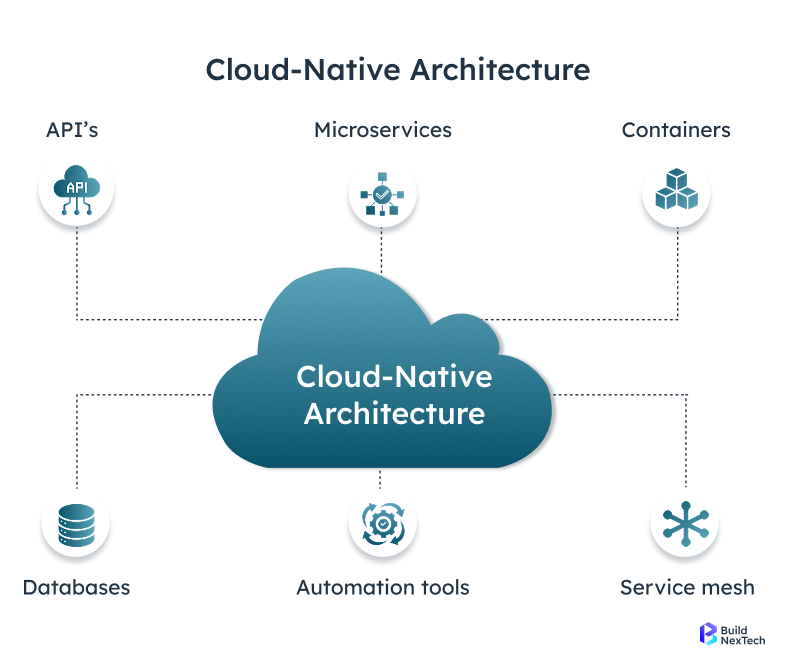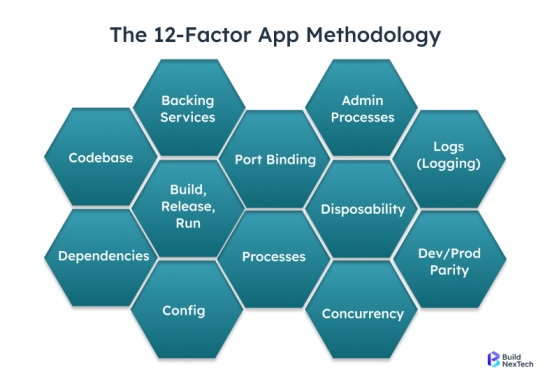Building cloud-native applications has become essential for businesses seeking scalability, flexibility, and competitive advantage in today's world. Understanding cloud-native architecture, containerization, and modern DevOps practices enables developers to create resilient applications that leverage the full potential of cloud computing.
💡 Key Insights from This Article
- Understand what cloud-native application development means and how it differs from traditional application development approaches
- Discover the core benefits of cloud-based application development including scalability, cost efficiency, and improved reliability
- Learn about essential cloud-native technologies like containers, Docker, Kubernetes, and microservices architecture
- Explore the 12-factor app methodology and its role in building maintainable, scalable applications
- Master the process of choosing the right cloud platform (AWS, Azure, Google Cloud Platform) for your specific needs
- Understand security implementation, deployment strategies, and monitoring practices for cloud-native applications
By mastering these concepts, you'll be equipped to build modern, scalable applications that harness the power of cloud infrastructure and deliver exceptional user experiences.
What is Cloud-Native Application Development?
Cloud-native application development represents a fundamental shift in how we design, build, and deploy software. Unlike traditional applications that are tied to physical servers or virtual machines, cloud-native applications are purpose-built for modern, dynamic, distributed cloud environments.
Key aspects of cloud-native development include:
- Cloud-first design: Applications are created from the ground up to take advantage of cloud services such as serverless computing, container orchestration, and distributed systems.
- Microservices architecture: Each feature or service operates independently, communicating via well-defined APIs, which enhances modularity and scalability.
- Modern practices (CNCF definition): According to the Cloud Native Computing Foundation, cloud-native technologies use containers, service meshes, microservices, immutable infrastructure, and declarative APIs to enable scalability across public, private, or hybrid cloud environments.
- Resilience and scalability: Unlike traditional monoliths, cloud-native apps are built to handle failures gracefully, scale horizontally, and update continuously without downtime.
In essence, cloud-native application development goes beyond technology—it’s a mindset that prioritizes adaptability, fault tolerance, and speed. By embracing these principles, organizations can deliver applications that thrive in ever-changing digital environments while ensuring seamless performance for end users.
Key Benefits of Cloud-Based Application Development
The shift toward cloud-native application development offers numerous advantages that directly impact business operations and user experience.
Cloud-native development offers transformative advantages that directly impact business operations and user experience.
- Enhanced scalability through automatic scaling based on demand, eliminating manual intervention
- Improved reliability via distributed architecture across multiple availability zones
- Cost optimization by paying only for resources used, preventing over-provisioning
- Faster time-to-market with continuous delivery and frequent updates
- Better developer experience through comprehensive tooling and automation
For businesses seeking competitive advantage, cloud-native applications provide the flexibility and resilience needed in today's dynamic market environment.
Cloud-Native Architecture: The Backbone of Scalable Apps

Cloud-native architecture forms the foundation of modern, scalable applications and emphasizes loose coupling and distributed systems principles.
- Microservices architecture breaks monolithic applications into independent services that communicate through REST or gRPC protocols
- Containerization packages applications with dependencies using Docker, ensuring consistency across environments
- Kubernetes serves as the leading container orchestrator for managing containerized applications at scale
- Service mesh tools like Istio provide communication infrastructure, handling security and traffic management
- API Gateway manages authentication, rate limiting, and routing for external requests
- Event-driven patterns use message queues like RabbitMQ, Kafka, or Amazon Simple Queue Service for asynchronous processing
This architectural approach enables independent development, deployment, and scaling of individual components while maintaining system resilience.
Understanding the 12-Factor App Methodology

The 12-factor app methodology provides essential best practices for building maintainable cloud-native applications.
- Codebase - Maintain a single codebase tracked in version control systems like GitHub or GitLab
- Dependencies - Explicitly declare and isolate dependencies to ensure consistent behavior across environments
- Configuration - Store configuration in environment variables rather than hardcoding values
- Backing services - Treat databases and message queues as attached resources that can be swapped without code changes
- Build, Release, Run - Strictly separate these stages using CI/CD pipelines with Jenkins, GitLab CI, or GitHub Actions
- Processes - Execute applications as stateless processes that communicate through port binding
- Disposability - Design for fast startup and graceful shutdown to improve fault tolerance
- Dev/prod parity - Maintain similarity between development and production environments
Following these principles ensures applications are portable, scalable, and ready for cloud platforms.
Choosing the Right Cloud Platform for Your App
Selecting the appropriate cloud provider significantly impacts your application's success and long-term scalability.
- Amazon Web Services offers the most detailed service catalog, including AWS Lambda for serverless computing and extensive data storage options
- Microsoft Azure excels in hybrid scenarios with seamless integration for .NET applications and enterprise DevOps tools
- Google Cloud Platform provides superior data analytics, competitive pricing, and strong Kubernetes support
- Heroku and Cloud Foundry offer simplified deployment experiences for specific use cases
- Consider existing technology stack, team expertise, compliance requirements, and budget constraints
- Many organizations adopt multi-cloud strategies to avoid vendor lock-in and leverage best-of-breed services
Each major cloud platform offers unique advantages for different application types and business requirements.
Cloud-Native Technologies: Kubernetes, Docker, and More
Understanding core cloud-native technologies is essential for successful application development.
Container Technologies Docker revolutionized application packaging through containerization. Containers provide lightweight, portable runtime environments that ensure consistency across different deployment targets. Docker Compose simplifies multi-container application management during development.
Kubernetes Ecosystem Kubernetes has become the de facto standard for container orchestration. It provides powerful abstractions for managing containerized applications at scale. Key components include pods, services, deployments, and ingress controllers. Tools like Minikube enable local Kubernetes development.
Storage Solutions Cloud-native storage addresses the challenge of persistent information in volatile containers. Solutions include Container Storage Interface (CSI) implementations, Container Attached Storage, and specialized tools like Rancher Longhorn for distributed storage.
Service Mesh Tools Service meshes provide advanced networking capabilities for microservices. Istio offers comprehensive traffic management, security policies, and observability features. These tools abstract complex networking concerns from application code.
Monitoring and Observability Tools like Prometheus for metrics collection, Grafana for visualization, and Jaeger for distributed tracing provide comprehensive observability. Fluentd handles log aggregation across distributed systems.
Setting Up Your Development Environment as a Cloud Developer
Creating an effective development environment is crucial for cloud-native application development.
Local Development Tools Start with containerization tools like Docker and Docker Compose for local development. Use Minikube or similar tools to run Kubernetes locally. Telepresence enables hybrid local/remote development workflows.
Infrastructure as Code Implement Infrastructure as Code practices using tools like Terraform. This approach ensures reproducible, version-controlled infrastructure deployments. Automation reduces manual errors and improves consistency.
CI/CD Pipeline Setup Establish Continuous Integration and Continuous Deployment pipelines using tools like Jenkins, GitLab CI, or GitHub Actions. Implement GitOps practices for declarative, automated deployments.
Development Frameworks Choose appropriate frameworks for your application stack. Spring Framework and Spring Boot excel for Java applications, while Node.js provides excellent performance for JavaScript-based services. Consider Spring Cloud for microservices-specific concerns like service discovery through Eureka and configuration management with Spring Cloud Config.
Implementing Security in Cloud-Native Apps
Security requires special attention in cloud-native environments due to their distributed nature and increased attack surface.
Container Security Implement security scanning for container images, use minimal base images, and regularly update dependencies. Tools like Containerd provide secure container runtime environments.
Secrets Management Use dedicated secrets management solutions like Secure Vault to handle sensitive information. Never hardcode credentials or API keys in application code or container images.
Network Security Implement network policies in Kubernetes to control traffic between services. Use service meshes to enforce security policies at the network level. Ensure proper authentication and authorization for all HTTP requests.
Security Standards and Policies Establish comprehensive security policies covering code scanning, vulnerability management, and compliance requirements. Implement security standards throughout the development lifecycle.
Deploying and Scaling Applications in the Cloud
Effective deployment and scaling strategies are essential for cloud-native applications.
Deployment Strategies Implement blue-green or canary deployments to minimize risk during updates. Use Kubernetes deployment objects to manage application lifecycle. Tools like Helm simplify complex deployments through templating.
Auto-scaling Capabilities Configure horizontal pod autoscaling in Kubernetes based on CPU, memory, or custom metrics. Implement cluster autoscaling to adjust infrastructure capacity automatically. This approach optimizes resource utilization and reduces infrastructure costs.
Resource Management Properly configure resource requests and limits for containers. Monitor resource usage patterns and adjust allocations accordingly. Use quality of service classes to prioritize critical workloads.
Monitoring and Managing Your Cloud-Native Application
Comprehensive monitoring and management practices ensure optimal application performance and reliability.
Observability Stack Implement the three pillars of observability: metrics, logs, and traces. Use Prometheus for metrics collection, centralized logging solutions, and distributed tracing systems like Jaeger with OpenTracing standards.
Performance Monitoring Monitor application performance metrics, including response times, error rates, and throughput. Set up alerting for critical issues and establish runbooks for incident response.
Health Checks and Resilience Implement health checks for all services and configure appropriate restart policies. Design for failure by implementing circuit breakers, retries, and fallback mechanisms.
Final Thoughts: The Future of Cloud-Native Application Development
Cloud-native application development represents the future of software engineering, powering the next wave of digital transformation. For businesses partnering with a mobile app development company like BuildNexTech, adopting cloud-native practices ensures applications are designed to be resilient, scalable, and agile enough to keep pace with evolving market demands.
Why the future of cloud-native development matters for businesses:
- Evolving ecosystem: The cloud-native landscape continues to expand with CNCF-backed projects, new frameworks, and standards. Staying updated through community engagement and industry events gives developers and businesses a strong competitive edge.
- Cross-platform focus: Partnering with a mobile app development agency that specializes in cross platform mobile app development ensures solutions are not only cloud-native but also deliver consistent performance across devices and platforms.
- Scalability and efficiency: Choosing the right mobile app development firm provides architectural expertise, operational excellence, and the ability to optimize costs while improving development velocity.
- Global reach: Businesses that work with a mobile app development company in USA or globally recognized partners like BuildNexTech gain access to best practices, cloud-native innovation, and enterprise-grade scalability.
In conclusion, success in cloud-native application development requires more than technical knowledge—it demands vision, adaptability, and strategic partnerships. By working with BuildNexTech, businesses can future-proof their applications, reduce operational overhead, and accelerate innovation through cloud-native, cross-platform, and mobile-first solutions.
People Also Ask
Can I build a cloud-native app without using containers like Docker?
Yes, you can use serverless functions, virtual machines, or Platform-as-a-Service offerings, but containers provide the best portability and scalability benefits.
Is it possible to make a cloud-native app fully offline-compatible?
No, cloud-native apps are designed to leverage cloud services and distributed architecture, making them inherently dependent on network connectivity.
Do cloud-native apps work across multiple cloud providers?
Yes, by designing with portability in mind—using containers, Kubernetes, and vendor-agnostic tools—you can run cloud-native apps across different providers and avoid vendor lock-in.
Can I mix monolithic and microservices in one cloud-native application?
Yes, this "strangler fig" pattern is common during migration, where you gradually decompose monoliths into microservices over time.


























.webp)
.webp)
.webp)

